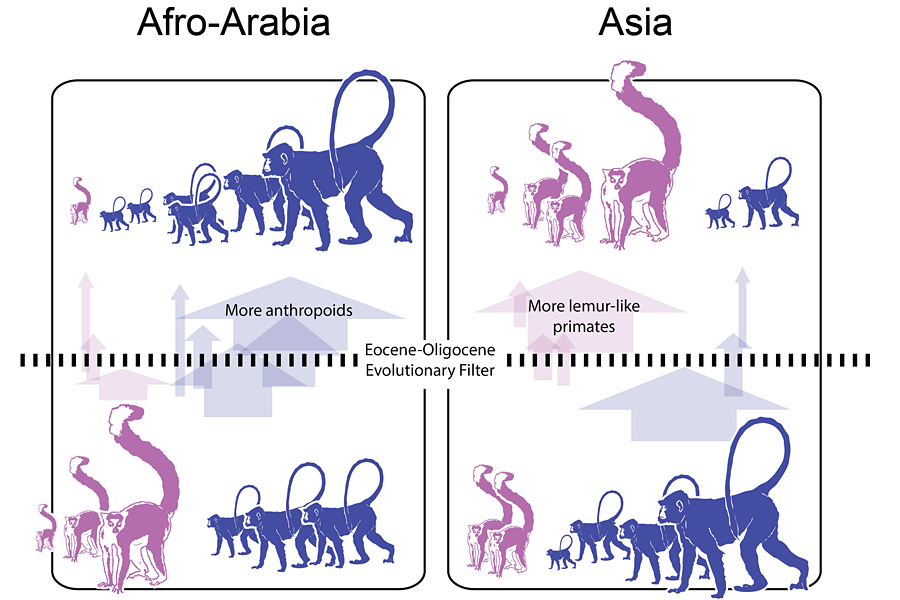Could these new fossils solve 'paradox' of primate evolution?
A dramatic change in climate some 34 million years ago – a global cooling – shifted the course of primate, and therefore our own, evolution.
An international team of researchers unearthed fossils of six new primate species that lived in Asia during that period, filling in a gap in the evolutionary story of primates. And this could help scientists resolve the "paradox" of why our own evolution happened in Africa, even though our primate lineage is thought to have originated in Asia.
The fossils, described in a paper published Thursday in the journal Science, illustrate how primate diversity in Asia changed with the climate at the end of the Eocene epoch.
During the Eocene, which ran from about 56 to 34 million years ago, the world's climate was in a greenhouse state. "This was a wonderful time to be a primate, because primates like things to be hot and muggy," says K. Christopher Beard, senior curator at the University of Kansas Biodiversity Institute and a coauthor on the new paper.
Primates thrived across many regions, including Europe, North America, Asia, and Africa during the Eocene, Dr. Beard tells The Christian Science Monitor.
But the epoch that followed, the Oligocene, was not so kind to these ancient primates. It became considerably cooler and drier across the globe.
Primates in many regions went extinct. Those that survived clustered around the equator or in the tropics, in Africa and Asia.
Scientists already had fossils representing the evolution of primates in Africa across the Eocene-Oligocene boundary, but little was known about the diversity of primates present in Asia during the early Oligocene, says John Fleagle, a primatologist at Stony Brook University and author of several books on primate evolution, who was not part of the new study.
These fossils, unearthed in southern China, "fill a gap," Dr. Fleagle tells the Monitor. They illuminate "a whole aspect of primate evolution that wasn't clearly documented before," he says.
What story do these new fossils tell?
During the Eocene, many species of primates lived across Asia and Africa. Many members of both branches of primates, the strepsirrhines and the haplorhines, populated both regions.
Of the six new species found at the Oligocene site in southern China, four are lemur-like members of the strepsrrhine lineage. A fifth is an ancestor of tarsiers, members of the haplorhine lineage that still live in southeast Asia today. And the sixth species is an anthropoid, also a haplorhine and a member of the lineage that includes monkeys, apes, and our own ancestors.
In the Eocene, more of the primates in Asia were anthropoids, says Beard. But come the Oligocene, "the anthropoids are dangling by a thread."
If primates had survived the Eocene-Oligocene transition only in Asia, anthropoid evolution might have continued to limp along or might have died out entirely. But while lemur-like primates took over southern Asia, primates in Africa responded to the cooler temperatures of the Oligocene differently.
There, primate diversity shifted the other way. Many non-anthropoid primates went extinct, providing an ecological window for anthropoid "radiation," an evolutionary term referring to a burst of new species filling new ecological roles.
"The anthropoid radiation – monkeys and apes and our monkey-ape ancestors – exploded in Africa," Fleagle says.
"This is kind of an answer to a paradox that we knew about before," Beard says. "All of the data that we have from the fossil record of primate evolution indicates that the very earliest anthropoids, the earliest members of this monkey, ape, and human group, actually originated in Asia, not in Africa. But we know by studying later chapters of this story that eventually the plot shifts from Asia to Africa."
"We never knew when and we never knew why. Now we know when for sure," he says.
The why is still a little more speculative, Beard says. Perhaps it was as simple as "two separate experiments in primate evolution" in which the groups evolved in isolation from each other, or perhaps there were environmental differences on the two continents that drove which primate groups were successful and which struggled.
"Evolution is incredibly complicated," Beard says. "This is a really good example of how evolution on two different continents at exactly the same time yielded almost exactly opposite results."
The fossils illustrate that "when climate changes, it has consequences for the animals that are used to the old climate," Fleagle says.
This story serves as a warning, Beard says.
"We now dominate the planet, but we're here based on a historical contingency that occurred 34 million years ago. Our distant ancestors faced a climatic challenge 34 million years ago and, in Asia, our closest ancestors were not able to meet that challenge. Ultimately the Asian anthropoids went extinct."







